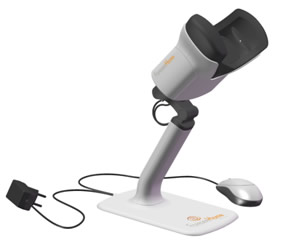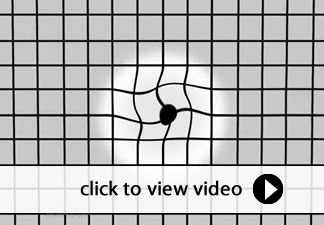ForeseeHome in Baltimore
Also serving Pikesville, Catonsville, Glen Burnie, & Rosedale
 In keeping up with the latest technological advances and in striving to deliver better patient care, we are very excited to offer the ForeseeHome AMD Monitoring Program.
In keeping up with the latest technological advances and in striving to deliver better patient care, we are very excited to offer the ForeseeHome AMD Monitoring Program.
The ForeseeHome AMD Monitoring Program provides frequent monitoring of patients at risk of developing wet AMD. By providing monitoring from a patient’s home, the program links patients and doctors between eye exams. Moreover, the ForeseeHome Monitoring program provides live, ongoing monitoring and alerts of significant changes in vision.
If you have been diagnosed with age-related macular degeneration, call 410-686-3000 and schedule a doctor consultation to determine if you are a candidate for the ForeseeHome AMD Monitoring Program.
a doctor consultation to determine if you are a candidate for the ForeseeHome AMD Monitoring Program.
For more information about the ForeseeHome AMD Monitoring Program, visit www.foreseehome.com or download the brochure.
AMD & the Amsler Grid
Until the introduction of the ForeseeHome, the only home monitoring method has been the Amsler Grid. The Amsler Grid has long been the standard recommendation for frequent monitoring of patients with age-related macular degeneration (AMD). Unfortunately, by the time a patient notices distortion on the Amsler Grid, vision loss has already progressed. The ForeseeHome AMD Monitor is not affected by the distinct limitations of the Amsler Grid.
ForeseeHome is covered by Medicare and most major insurances.
The ForeseeHome Device
 ForeseeHome is an at-home device with a closed viewer that examines one eye at a time for age-related macular degeneration (AMD) progression, identifying when dry AMD turns into wet AMD. A set of lenses is embedded in the viewer to ensure the patient sees the projections from “infinity,” meaning a patient with good distance vision can visualize the test in maximum focus. The 3.5-pound device is about 16 inches tall and sits on your dining table or another surface. ForeseeHome features a mouse and USB interface with a modem connected to the Internet.
ForeseeHome is an at-home device with a closed viewer that examines one eye at a time for age-related macular degeneration (AMD) progression, identifying when dry AMD turns into wet AMD. A set of lenses is embedded in the viewer to ensure the patient sees the projections from “infinity,” meaning a patient with good distance vision can visualize the test in maximum focus. The 3.5-pound device is about 16 inches tall and sits on your dining table or another surface. ForeseeHome features a mouse and USB interface with a modem connected to the Internet.
How ForeseeHome Works
The ForeseeHome device uses preferential hyperacuity perimetry (PHP), a patented technology that identifies and quantifies vision abnormalities, such as scotoma (blind spots) and metamorphopsia (shape distortions). Hyperacuity is the ability of the human eye to perceive tiny differences in the relative location of two options. ForeseeHome tests present each eye with stimuli for 160 milliseconds. These stimuli flash in various areas of your visual field and consist of a series of dots. Some of the dots are misaligned to create an artificial distortion or wave that the patient identifies by clicking on the area with the mouse. The brief presentation of the stimuli makes sure the brain doesn’t fill in the space (a process called cortical completion).
The patient starts the at-home test by inserting their head in the viewer. A pair of infrared sensors ensure the head position is correct, and the patient rotates the viewer to test each eye. The signal is triggered when the patient’s eye fixates on the center of the screen. The test takes a few minutes per eye. The device sends the results to the Notal Vision Monitoring Center and alerts the physician’s office if the results show significant vision changes that may indicate AMD progression.
How ForeseeHome Identifies AMD Progression and Vision Changes
A healthy eye looks at the viewer and sees a straight line interrupted by a hump or curve and selects that distortion. A patient with vision changes caused by AMD will look at the stimuli and see two distortions: one is the artificial wave, and the other is caused by vision damage. Patients with blind spots in their central vision may only see one visual distortion created by their macular damage, not the artificial one.
ForeseeHome uses 500 data points within 14 degrees of the central visual field. These data points are screened three to five times to identify vision gaps or distortions. If the device suspects a vision issue, it brackets that part of the macula to investigate the distortion or blind spot. The device’s algorithm presents the patient with more stimuli over the damaged area of the macula to locate and quantify it, determining the shape and size of the patient’s vision gaps. Then, ForeseeHome creates an Alert Metamorphopsia Map and sends it to the Eye Care Professional Portal for our eye doctors at Elman Retina Group to review.
Benefits of ForeseeHome
ForeseeHome is FDA-cleared for home use and is covered by Medicare and most private insurance providers. The progression from dry to wet AMD happens rapidly, leading to severe, irreversible vision loss without prompt diagnosis and treatment. ForeseeHome allows our eye doctors to detect wet AMD earlier and preserve functional vision for at-risk patients by starting treatments earlier. Test results are automatically sent to your provider. This quick and easy at-home device can save your eyesight!
Foresee Home Vs. Amsler Grid
 Wet AMD starts with subtle changes that are not noticeable in your vision because your brain compensates with the visual clarity in your other eye, filling in the missing areas with patterns and colors of the surrounding environment. Clinical trials showed only one-third of patients with dry AMD that progressed to wet AMD noticed vision changes.
Wet AMD starts with subtle changes that are not noticeable in your vision because your brain compensates with the visual clarity in your other eye, filling in the missing areas with patterns and colors of the surrounding environment. Clinical trials showed only one-third of patients with dry AMD that progressed to wet AMD noticed vision changes.
The Amsler grid is a black-and-white grid with a dot in the center that patients look at daily to see if lines look wavy or distorted or if there are missing areas in their vision. The issue is that these distortions or blind spots appear after irreversible central vision loss. The Amsler grid has limitations for early detection because vision loss has already occurred. A large study with the ForeseeHome device found that 81% of patients maintained good functional vision when wet AMD was detected with the device compared to just 34% of patients relying on the Amsler Grid or other vision detection methods.




